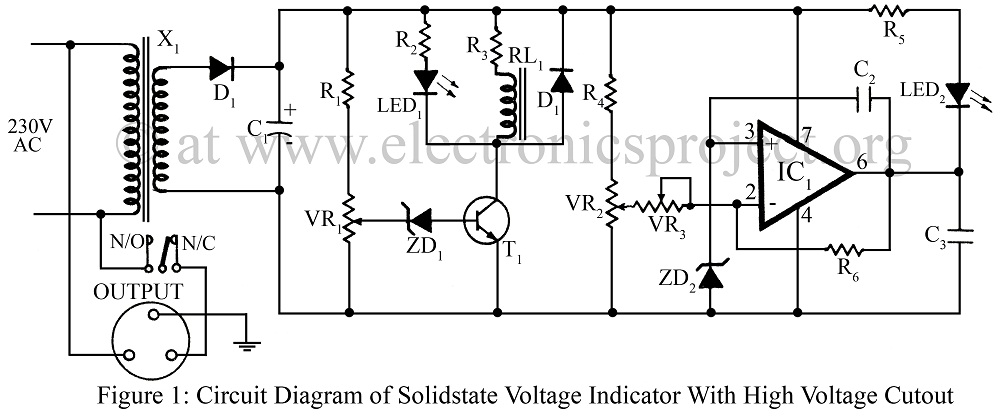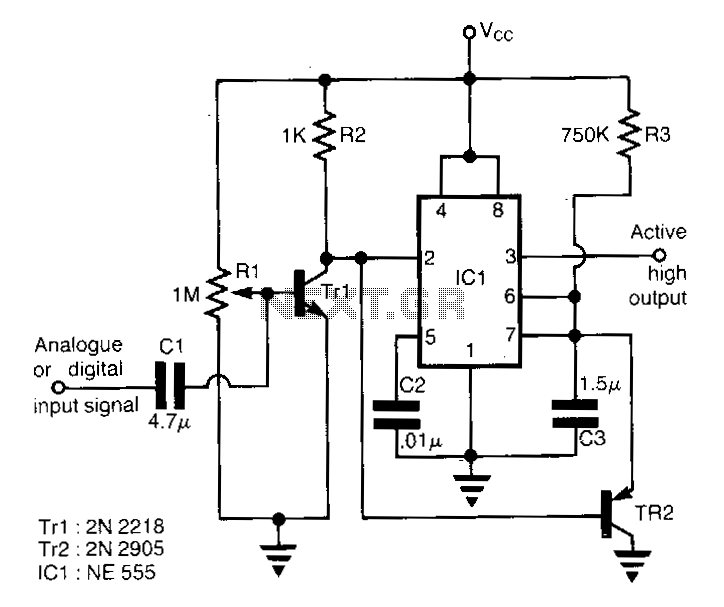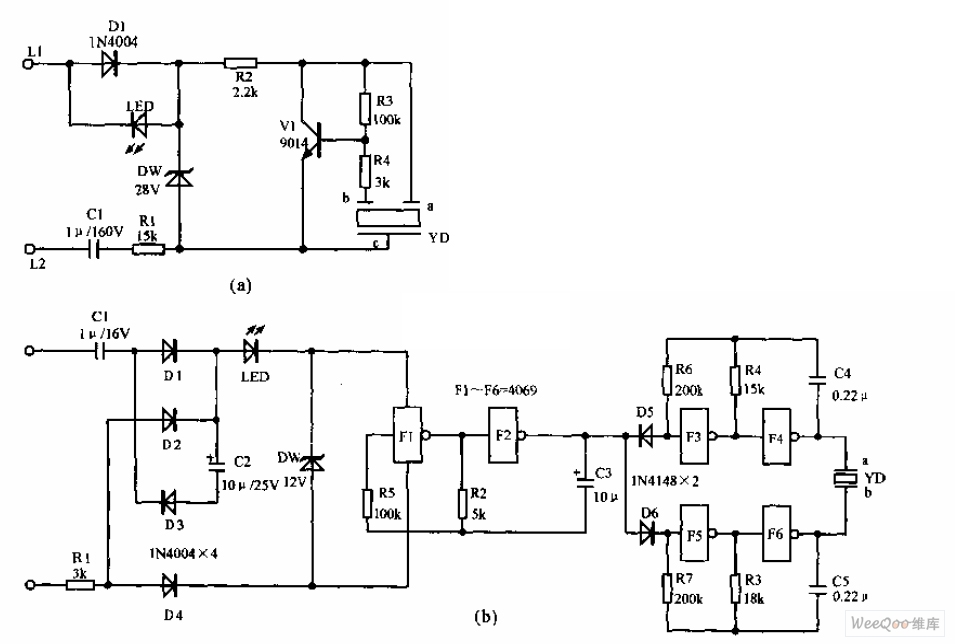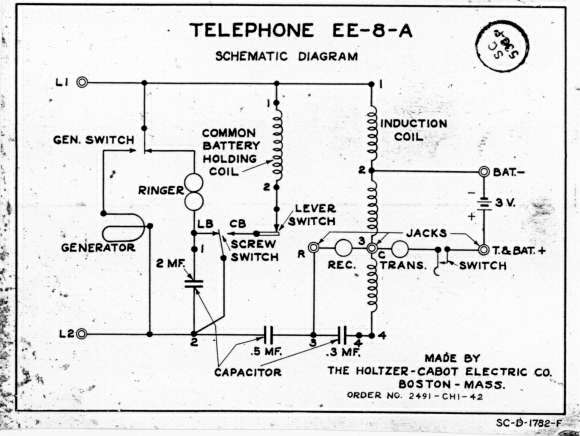
Telephone Free Indicator
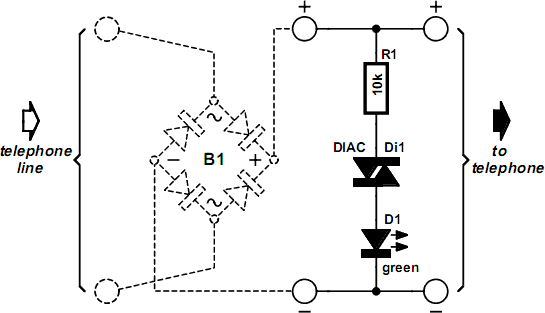
Depending on local regulations and the telephone company to which one is connected, the voltage on a free telephone line can range from 42 to 60 volts. This voltage is sufficient to cause a diac to conduct, functioning similarly to a zener diode and maintaining a voltage of approximately 38 volts. The current generated during this process causes the high-efficiency green LED in the circuit to illuminate. If the line voltage exceeds about 50 volts, it may be necessary to replace resistor R1, originally rated at 10 kΩ, with a component of a slightly higher value. When the telephone receiver is lifted, the line voltage typically drops to less than 15 volts (around 12 volts), causing the diac to block and the LED to turn off. The circuit diagram indicates the positive and negative terminals of the phone lines. However, in several countries, the line polarity may reverse when a call is initiated. To ensure the circuit operates correctly under these conditions, a bridge rectifier can be incorporated, as represented by the dashed outlines. This bridge rectifier, which can consist of four discrete diodes such as 1N4002s or similar, will render the circuit independent of any polarity variations on the phone line. It is important to note that this circuit is not approved by the British Approvals Board for Telecommunications (BABT) for connection to the Public Switched Telephone Network (PSTN) in the UK.
The described circuit utilizes a diac, a type of semiconductor device that exhibits a sharp change in conductivity at a specific voltage threshold. In this application, the diac is employed to control the illumination of an LED based on the voltage present on the telephone line. The circuit is designed to operate within the specified voltage range and to respond appropriately to variations in line voltage.
The resistor R1 plays a critical role in limiting the current flowing through the diac and the LED. When the line voltage exceeds the diac's breakdown voltage, it conducts, allowing current to flow and illuminating the LED. The choice of R1's resistance value is crucial, particularly when considering the maximum line voltage. If the line voltage is consistently above 50 volts, increasing R1's value will help to prevent excessive current that could damage the components.
The inclusion of a bridge rectifier is a significant enhancement to the circuit's versatility. By allowing for both polarities of the incoming voltage, the circuit can function correctly regardless of the orientation of the telephone line connection. This is particularly useful in regions where telephone line polarity may vary based on the service provider or local regulations.
In summary, this circuit effectively demonstrates the use of a diac and LED to create a visual indicator based on telephone line voltage. The addition of a bridge rectifier ensures compatibility with varying line polarities, while careful selection of resistor values helps maintain safe operating conditions for the components involved. However, it is imperative to adhere to local regulations and standards, as this particular design is not approved for connection to the PSTN in the UK.Depending on local regulations and the telephone company you happen to be connected to, the voltage on a free telephone line can be anything between 42 and 60 volts. As it happens, that`s sufficient to make a diac conduct and act like a kind of zener diode maintaining a voltage of 38 V or so.
The current required for this action causes the green h igh-efficiency LED in the circuit to light. Line voltages higher than about 50 V may require R1 to be changed from 10 k to a slightly higher value. When the receiver is lifted, the line voltage drops to less than 15 V (typically 12 V) causing the diac to block and the LED to go out.
The circuit diagram indicates + and with the phone lines. However, in a number of countries the line polarity is reversed when a call is established. To make sure the circuit can still function under these circumstances, a bridge rectier may be added as indicated by the dashed outlines. The bridge will make the circuit independent of any polarity changes on the phone line and may consist of four discrete diodes, say, 1N4002`s or similar.
Finally, note that this circuit is not BABT approved for connection to the public switched telephone network (PSTN) in the UK. 🔗 External reference
The described circuit utilizes a diac, a type of semiconductor device that exhibits a sharp change in conductivity at a specific voltage threshold. In this application, the diac is employed to control the illumination of an LED based on the voltage present on the telephone line. The circuit is designed to operate within the specified voltage range and to respond appropriately to variations in line voltage.
The resistor R1 plays a critical role in limiting the current flowing through the diac and the LED. When the line voltage exceeds the diac's breakdown voltage, it conducts, allowing current to flow and illuminating the LED. The choice of R1's resistance value is crucial, particularly when considering the maximum line voltage. If the line voltage is consistently above 50 volts, increasing R1's value will help to prevent excessive current that could damage the components.
The inclusion of a bridge rectifier is a significant enhancement to the circuit's versatility. By allowing for both polarities of the incoming voltage, the circuit can function correctly regardless of the orientation of the telephone line connection. This is particularly useful in regions where telephone line polarity may vary based on the service provider or local regulations.
In summary, this circuit effectively demonstrates the use of a diac and LED to create a visual indicator based on telephone line voltage. The addition of a bridge rectifier ensures compatibility with varying line polarities, while careful selection of resistor values helps maintain safe operating conditions for the components involved. However, it is imperative to adhere to local regulations and standards, as this particular design is not approved for connection to the PSTN in the UK.Depending on local regulations and the telephone company you happen to be connected to, the voltage on a free telephone line can be anything between 42 and 60 volts. As it happens, that`s sufficient to make a diac conduct and act like a kind of zener diode maintaining a voltage of 38 V or so.
The current required for this action causes the green h igh-efficiency LED in the circuit to light. Line voltages higher than about 50 V may require R1 to be changed from 10 k to a slightly higher value. When the receiver is lifted, the line voltage drops to less than 15 V (typically 12 V) causing the diac to block and the LED to go out.
The circuit diagram indicates + and with the phone lines. However, in a number of countries the line polarity is reversed when a call is established. To make sure the circuit can still function under these circumstances, a bridge rectier may be added as indicated by the dashed outlines. The bridge will make the circuit independent of any polarity changes on the phone line and may consist of four discrete diodes, say, 1N4002`s or similar.
Finally, note that this circuit is not BABT approved for connection to the public switched telephone network (PSTN) in the UK. 🔗 External reference
